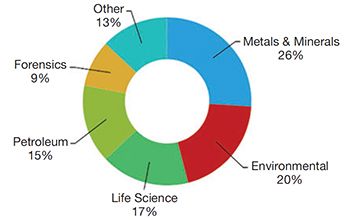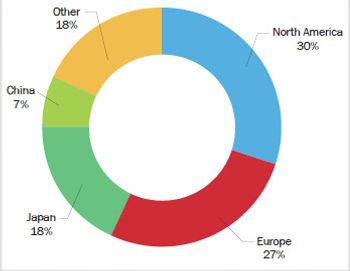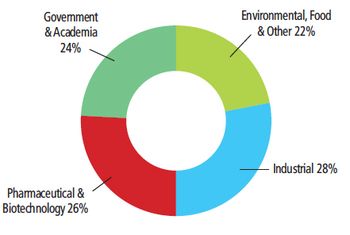
- Spectroscopy-02-01-2017
- Volume 32
- Issue 2
Market Profile: Raman Spectroscopy
Raman spectroscopy is one of the fastest growing segments of the molecular spectroscopy techniques.
Raman spectroscopy is one of the fastest growing segments of the molecular spectroscopy techniques. Unlike other molecular spectroscopy techniques such as UV–vis, which measure light absorbed by the sample, Raman spectroscopy involves the measurement of light scattered off a sample. Raman spectroscopy is quite versatile and can measure samples through transparent containers such as glass and plastic. Measuring the light scatter is an important analytical methodology because it allows for a direct, nondestructive analysis of solids, liquids, and gases with little to no sample preparation, making it very practical and easy to use.
Raman instruments come in several categories. Benchtop microscope systems are the highest end instruments typically used for research and routine applications. Because these systems are fixed in a laboratory, the system can be equipped with advanced automation, focus tracking, data collection, calibration mechanisms, and sophisticated visualization software, amongother features. The use of portable and handheld Raman instruments has migrated the technology outside the lab and into the field including online and at-line process applications. One of the key applications is the inspection of raw materials in chemical and pharmaceutical facilities. It is also used for homeland security, defense, and forensic applications for the identification of explosives, TSA screening, and narcotics screening at a crime scene. The systems are also being used for checking counterfeit products, particularly prescription drugs and diluted edible oils. Raman technology continues to advance, which will likely broaden the reach of its current applications. For example, surface enhanced Raman scattering (SERS) is a technique that increases the Raman intensity by many orders of magnitude, allowing for single molecule detection. SERS is currently being applied in applications where sensitivity and speed is perhaps beyond standalone Raman instrument capabilities such as trace material analysis. The US market for Raman spectroscopy accounted for about $125 million in 2016, led by Bruker, Horiba, and Thermo Scientific. The demand for portable and handheld instruments has become the largest segment, although microscope Raman systems remain the workhorse for academic research, industrial R&D, and quality assurance applications. The following market information was extracted from new data and analysis from independent market research firm, Top-Down Analytics. For more information, contact Glenn Cudiamat, General Manager at (888) 953-5655 or
Articles in this issue
almost 9 years ago
Understanding Data Governance, Part Ialmost 9 years ago
Frontiers of Far-Ultraviolet Spectroscopy in the Solid and Liquid Statesalmost 9 years ago
Bias and Slope Correctionalmost 9 years ago
Vol 32 No 2 Spectroscopy February 2017 Regular Issue PDFNewsletter
Get essential updates on the latest spectroscopy technologies, regulatory standards, and best practices—subscribe today to Spectroscopy.




